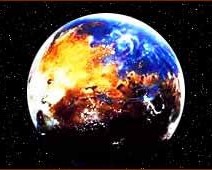 |
| What We Know About the Red Planet | ||||
| History | Water | Ice | Air | Canals |
| Seasons | Mountains | Rocks | SandDunes | Rift Valley |
| Moons | Dust Storms | Stats | Closest | Kid Pix |
| Lunar | Movies | Life Search | Wanted | Exploring Mars |
Nothing fires the imagination more than Mars:
Why Is It Called the Red Planet?
No other world has tickled the human fancy more than Mars. It seems nothing in Outer Space fires the imagination more than what we know today as the Red Planet.
Humans have wondered about the mysteries of the planet Mars since the Babylonians began exploring the skies with astronomy in 400 B.C. To those people in ancient times, Mars looked like a red star passing through their night sky.
The color red was associated with blood, thus death and war. The people of ancient times also associated the small reddish "star" with the element iron and men used iron weapons to wage war.The moons of Mars are named "Phobos" and "Deimos." In Greek mythology, those were the names of the sons of the god of war. The larger moon is Phobos, meaning "fear," and the smaller is Deimos, meaning "panic."
- The Egyptians called it the "Red One."
- The Sumerians, who lived in what we now call the Middle East on the territory of modern Iraq, called the small red dot in the sky the "Star of Death," and named it after Nergal, their god of war and death. From that time, the fourth planet from the Sun has been named for a god of war.
- The Greeks referred to it as "Ares," for their god of war.
- The Romans saw it as an angry light in the heavens worthy of the name of their mythical god of war, "Mars." That name has lasted.
- Today, we also refer to Mars as the "Red Planet" because it is easily distinguished in the night sky by its reddish color, which comes from rusty sand and rocks that cover the Martian surface.
Learn more: Human Exploration of Mars:
There have been three stages of exploration so farFlybys:
Probes fly by Mars taking pictures Orbiters:
Spacecraft fly into orbit above MarsLanders and Rovers:
- Orbiters
- Mariner 8-9
- Viking 1-2
- Mars Observer
- Mars Climate Orbiter
- Mars Global Surveyor
- Mars Global Surveyor home
- 2001 Mars Odyssey
- 2001 Mars Odyssey home
- Mars Express
- Mars Express home
- Mars Reconnaissance Orbiter 2005
- Mars Reconnaissance Orbiter home
Landers and rovers drop to the surfaceSand dunes: Dust Storms: Air: Carbon Dioxide: Outflow Channels: Valley Networks: Rift Valley: Ice: Ice caps: Frost: Water: Artesian Water: Mars Weather: Mars Photo Galleries: Planet features: Canals: Rocks: Mountains: Dating and aging: Seasons:
